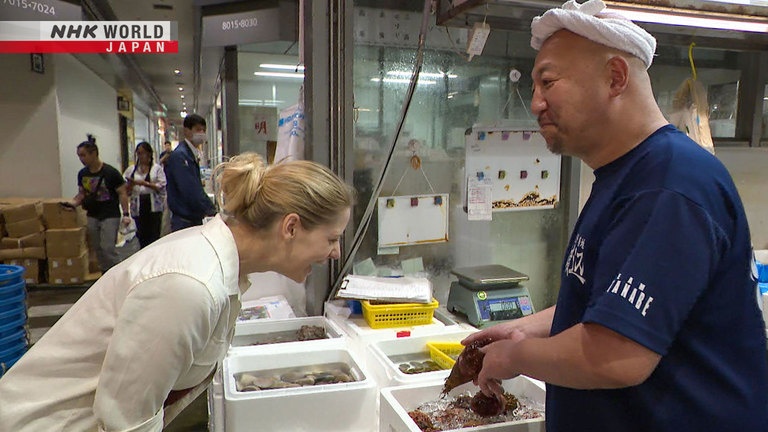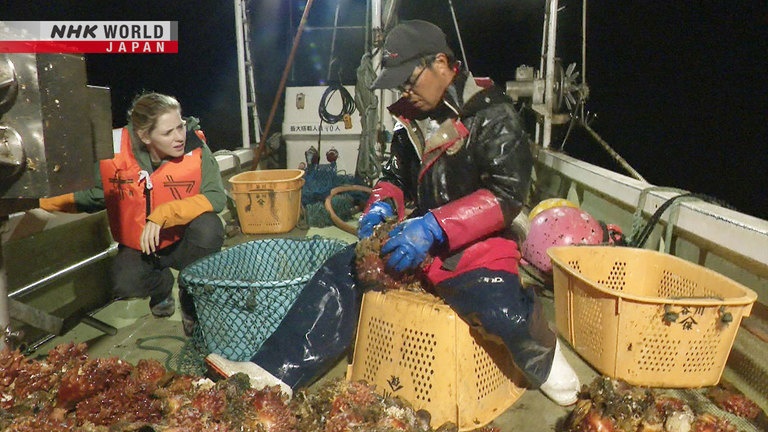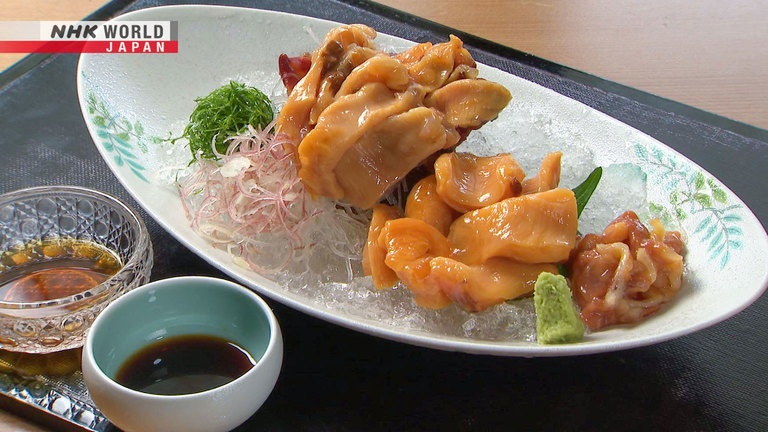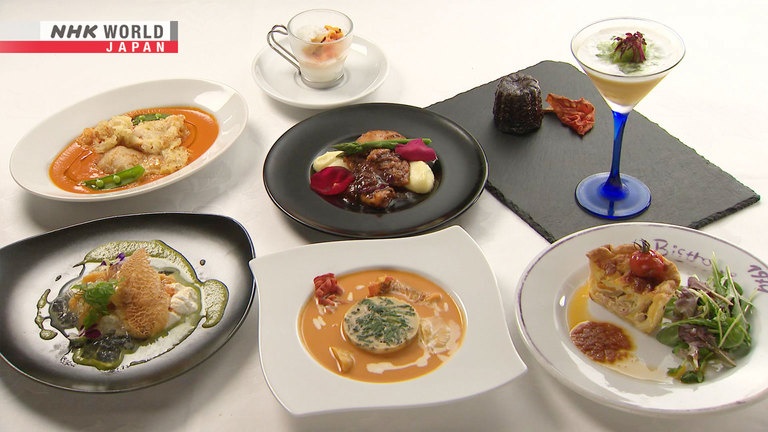HOYA
The hoya, or sea pineapple, is one of the ocean's hidden delicacies. Protected by a hard shell, the marine animal's meat offers a wide range of flavors, including rich umami. In Miyagi Prefecture, hoya aquaculture has come a long way since the devastating tsunami that followed the Great East Japan Earthquake of 2011. Feast your eyes on an array of dishes featuring the edible ascidian, and discover how a restaurant in Tokyo is breathing new life into French cuisine. (Reporter: Janni Olsson)




Transcript
Tokyo: this world-class metropolis is a veritable gourmet wonderland.
Discover the stories behind the ingredients that make this city so delicious, so "oishii."
Introducing "hoya," known as "sea pineapple" in English.
It's a funny-looking thing indeed.
It has lovely orange meat with a soft, plump texture.
And it's packed with flavor: it's sweet, sour, bitter, salty, and has tons of "umami."
- Eat it with this?
- Yes.
Sweet!
Wow, okay.
Hoya's in season from May to August.
Packed with iron and vitamin E, it's quickly gaining traction as a health food.
Recently, hoya's being used in all kinds of recipes beyond Japanese cuisine.
Discover more about hoya, one of the ocean's hidden delicacies.
Trails to Oishii Tokyo.
Hello. My name is Janni Olsson, and the theme of today's show is "Hoya."
Now, this is an ingredient I don't really know anything about.
I've been living here for so many years, but there's still so many wonderful ingredients I haven't heard anything about.
Well, let's go.
Come on.
Janni begins in Toyosu Market, where foods from all over Japan are traded.
Here, in the market's largest building, you'll find around 500 seafood wholesalers.
Among them is a unique vendor specializing in shellfish.
- Hello.
- Good morning.
- So many shellfish.
- Right, that's what we sell.
All shellfish?
Opened in 1935, the shop has specialized in seasonal shellfish from all parts of Japan.
What's in season now?
"Hamaguri" here, and these. Hoya.
- That's hoya?
- Right.
And there it is!
Its appearance reminds her of a certain tropical fruit.
- Is it a shellfish?
- No, it's not.
- A marine plant?
- A marine animal.
- Oh, wow.
- It's called a sea pineapple, because of how it looks.
I see it!
Although considered marine animals, hoya are invertebrates, and lack a skeletal system.
They're commonly found sticking to rocks and shells.
The name apparently comes from the old Japanese word for lampshade.
Edible meat is found within.
This is the inside.
Interesting.
It's similar to a shellfish.
Remove the shell to find tasty orange meat with a plump and fibrous texture.
How does it taste?
Sweet, salty, and a little bitter.
It's hard to describe.
How do you know which ones are tasty?
They need to be plump like this one.
It's firm with some elasticity.
This guy's been selling hoya for decades.
He'll tell you everything.
An experienced staff member will explain its features.
There's a hole that looks like a plus sign.
Water is sucked in through there.
They excrete through this hole,
which looks like a minus sign.
That's the gist of it.
A true wonder of the natural world.
Where is good hoya caught?
The two major areas are Miyagi and Iwate.
- I guess I'll have to go there.
- Alrighty.
Thanks for the info.
Enjoy eating it fresh from the source.
Janni's off to Ishinomaki in Miyagi, about 400 kilometers north of Tokyo.
The region is a center for hoya aquaculture.
Warm and cold waters mix off the Pacific coast, offering one of the world's top fishing grounds.
Janni's first stop is a Japanese restaurant with over 100 years of history.
- Hello.
- Welcome.
- Nice to meet you. I'm Janni.
- We've been expecting you.
Fourth-generation owner Abe Tsukasa launched a full course hoya menu to promote the local specialty.
Hoya can be eaten fresh, just remove the black innards first.
Here you are.
Some hoya sashimi.
Hoya can be eaten several ways.
The full course meal includes sashimi, tempura, hoya rice, and other side dishes.
Sashimi is the best way to enjoy hoya's complex flavor.
Abe has a knack for highlighting the textures of each section.
This is the section that takes water in and out.
It's quite crunchy.
This is the center.
I cut it against the fibers.
This is the bottom part.
It's meaty, sweet, and delicious.
I serve it in larger pieces.
"Itadakimasu."
Okay, here we go.
It's sweet.
- It reminds me of sea urchin.
- It's a similar flavor.
- A little bit, yeah.
- The sweetness, too.
- Right.
- Quite similar.
It doesn't appear to be very fresh.
- It has a subtle sweetness.
- Right.
"Oishii."
The three dishes are made with the sort of skill you'd expect from a long-established Japanese restaurant.
This is hoya simmered in bonito "dashi" stock, served with a leafy green called "komatsuna."
This is hoya, tomato, and onion steamed in oil.
And this is hoya steamed in sake, topped with a tangy tofu dressing.
Last up is hoya rice, cooked in an iron pot.
It has shiitake mushrooms.
With bamboo shoots. And hoya, of course.
Here they are.
"Itadakimasu."
A totally different flavor.
The "umami" of the hoya comes out a bit more here.
That's because I used 1.5 whole hoyas.
Wow.
The juices of the raw hoya soak
into the rice as it all cooks together.
So, the dish is packed with "umami."
Yes, it really is. It's excellent.
It's perfect for hoya lovers.
I want my dishes to highlight hoya's "umami."
That's the best way to serve it,
since it's comparable to sea urchin.
This is the first time I got the chance to try hoya, and it's really, really delicious.
It's really fresh, it has a lot of sweetness to it, and, depending on which part of it you eat, you get a lot of different texture.
So... it's really versatile, actually, as an ingredient.
So, super surprised in a good way.
Janni visits a port late at night to meet with an expert hoya fisher.
- Good evening!
- Hello.
- Are you Mr. Atsumi?
- Yes.
- Permission to come aboard?
- Sure, no problem.
Thank you.
Hoya are retrieved in the middle of the night.
Why fish so late?
Hoya need to be as fresh as possible,
so they're taken at night when it's cool.
Then, they're delivered to sellers and
processors first thing the next morning.
Ah, that's why.
Isn't it hard working in the dark?
Well, I'm used to it.
I want to deliver the best hoya.
Atsumi gives new hope to Ishinomaki, a region thriving with hoya.
Fifteen minutes out, they reach their destination.
I don't know how this works.
Do you use nets or baskets?
Ropes, actually. Hoya cling to them.
- They're cultivated on ropes
rather than simply fished?
- Exactly.
He reels it in.
Ah, there!
Janni gets more than she signed up for!
Wow, okay.
They're spraying water from the minus sign holes!
I've seen a lot of different kind of ways to catch fish, and shellfish, and these kinds of things, but this is kind of special.
When you pull it out the water, from the hoya it got squeezed out of them.
So, you've got kind of a waterpark here, with like.. water flying all over the place.
I've never seen anything like it before.
It was something new.
Each rope holds about 150 hoya, with a total weight of around 50 kilos.
How do they attach to the ropes?
These oyster shells act as beds.
Really?
I put babies in the shells
and nurture them for 4-5 years.
So new hoya fishers can't sell anything
for the first several years?
Right, not for 3 years or so.
- Nothing?
- Nothing to sell.
That's tough.
Hoping to be a fisher from a young age, Atsumi began training with a mentor at the age of 21.
But one year after his first hoya shipment, the Great East Japan Earthquake hit.
With his career turned upside down, he thought about giving up completely.
At the time, the future of
Japanese fishing looked bleak.
But being a fisher was my calling.
I needed to rebuild the foundation for
our children, for future generations.
I had to give it another shot.
Twelve years after the disaster, hoya is a symbol of revitalization.
It's 3:30 in the morning.
Atsumi's work continues back at port, hauling fresh hoya to a nearby shipping area.
Okay, so it's four o'clock in the morning now, and they are preparing to send off the hoya.
Let's go take a look.
Excrement will now be rinsed off, before the hoya are sorted in baskets.
The staff work in a line to load the hoya onto a truck.
Only four hours pass from retrieval at sea to shipping directly to supermarkets.
That was fast.
That was probably the fastest shipping process I've seen so far on this show.
Super fast.
Hoya is also used to make a number of processed goods.
So, in this store they sell all kinds of famous goods from this city.
So, let's start over there, and see what they have.
Let's see what she finds.
Okay, so we have "iburi-hoya," smoked hoya.
And this... "kaki"... hoya!
Oh, my God.
This is a spicy one, I think.
Just when she thought she'd seen it all...
Hoya "tamago?"
Hoya eggs.
One capsule costs about three dollars.
Okay, that's super small.
What is this?
Okay, so, I actually got this out from a "gacha"... I think you say that in English as well.
So, it's in this plastic shell.
We have these in Sweden, but then, you only kind of get toys...
I've never gotten an egg out from a gacha before, so... let's try.
Janni's in for a feast.
Well, let's see.
Wow, it really is an egg in here. Okay.
Is this egg, really?
Ah, okay, so it's hoya on the outside, and egg on the inside.
Of course it is.
So this is the hoya.
Okay, I guess I'm just going to take a bite.
Here we go.
It actually goes really well together with the egg.
So... in this case, the hoya is kind of salty, and then you get this... mild flavor from the inside of the egg.
It's actually really good.
And it's really cute.
This fun hoya snack is actually a regional delicacy.
In Ishinomaki, hoya are eaten in a traditional New Year's dish.
- Hello.
- Yes.
- Hello.
- Nice to meet you. I'm Janni.
Hi, Janni. Welcome.
Please, come in.
Okutsu Takako, a friend of Atsumi, the hoya fisher, will cook up some local dishes for Janni.
Let's grill this.
It goes on the grill?
And doing that...?
It's more flavorful that way.
It makes a better broth too.
It smells great.
Yes, it turned out nice.
Grilling cooks out moisture, and condenses "umami."
She adds the hoya to a pot containing "daikon" radish, carrots, and threaded "konnyaku."
Hoya have great aroma.
They're tasty and make good broth.
I'll add "seri" leaves now.
Rice cakes and "seri" herbs go in last.
And that's it.
It's ready. Try some.
It looks wonderful.
- Enjoy.
- Thank you.
"Zoni" is a traditional soup eaten during the Japanese New Year.
In Ishinomaki, it contains hoya.
Orange is a lucky color in Japan, that's often used for New Year's decorations, so hoya is a perfect food for the season.
Great presentation.
Very colorful.
It's hoya "zoni" soup.
Have a taste.
Thank you.
So, the flavor actually quite changes from after you put the hoya in it.
So, you get a lot more "umami" in there, even though it was really quick to make.
So, it's really packed with all these flavors.
The hoya makes a big difference. "Oishii."
I'm glad you like it.
"Zoni" recipes differ by region, and Ishinomaki's hoya "zoni" is a real feast for the eyes.
Back in Tokyo, Janni heads to a restaurant in Ebisu that offers a full course hoya meal.
- Hello.
- Welcome.
Nice to meet you. I'm Janni.
I'm Muto. Welcome.
Thanks for having me.
I'll take you to your seat.
Opened about 50 years ago, the bistro serves homemade French cuisine.
Chef Muto Tetsuya prides himself on using fresh regional ingredients.
His interest in hoya began about five years ago.
Impressed by hoya's complex flavor, Muto was determined to add the ingredient to his repertoire.
Here you are.
- Looks lovely.
- Right?
Very.
This is hoya carpaccio.
- It works with carpaccio?
- Yes.
It's surrounded by a cucumber vinaigrette.
Underneath is a seasonal onion mousse.
It's French-style sashimi,
eaten without soy sauce.
- Should I dip it in the sauce?
- Yes.
Mix it around and take a bite.
"Itadakimasu."
Here we go.
This is so good.
- Delicious.
- Thank you.
The sweetness of the hoya and
that of the onion create synergy.
That's it. The sweetness of the onion
comes out as you chew.
And it changes as you go.
- You got it.
- Yeah?
The sweetness evolved with each bite.
Hoya itself has five flavors.
Pairing it with certain sauces and mousses will
bring out different flavors as you chew.
- Amazing. How fun.
- Right?
I'm hooked.
Muto's specialty? His version of bisque, a famous French seafood soup.
Instead of crustaceans, Muto makes bisque with the hoya's outer layer.
A creamy soup packed with hoya flavor.
An egg custard lies in the center.
Hoya has a lot of depth to its flavors and "umami."
What made you use hoya in French cuisine?
After the region's major earthquake,
hoya sales declined in Ishinomaki.
I heard that fishermen had been struggling for years,
and thought using hoya more would boost sales.
So, I started using it in French recipes.
Every day for a month, Muto experimented with different recipes and cooking methods, to accent different hoya flavors.
This resulted in 60 new recipes.
The main dish is hoya cooked in red wine and garnished with aromatic rose petals.
Maybe hoya goes well with red wine, because it's technically an animal, rather than a fish or shellfish...
The bitterness inside the hoya
matches with that of the red wine.
It makes a really nice sauce.
"Itadakimasu."
- So delicious.
- Thank you.
It's great with the red wine sauce.
I didn't know hoya was this versatile.
Now for dessert.
- Hoya even for dessert?
- Of course.
Where is it?
Mango and hoya were blended into a mousse.
It's in the mousse!
Right.
Once you swallow the mousse,
the hoya flavor comes out.
Right, the flavor changes again.
What a fascinating ingredient.
It really is. It's very interesting.
Thank you for today.
The full course meal includes a total of eight dishes.
It's available during hoya season, by reservation only.
With so many hidden possibilities, hoya is destined to inspire chefs all across the globe.
When I first saw hoya at the fish market, I thought that it was going to be an ingredient that was quite difficult to use,
and also that it would have a quite distinct taste and smell.
However, throughout my journey, I learned that it can be used in so any different ways and that it is delicious.
So, I hope that you guys also give this unique ingredient a chance.
I bet you'll love it.
In Tokyo, every ingredient has its own story.